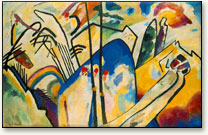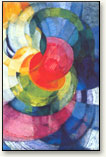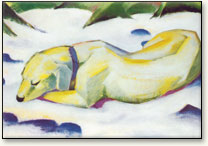Modern Art Influenced by Vision

Monet’s Haystacks played a crucial role in the emergence of modern art and inspried Vasily Kandinsky to create a series of abstract compositions, including this Composition V, 1911.
In 1896, Wassily Kandinsky (1866-1944) sees Monet’s “Haystacks” in a touring exhibition in St. Petersburg. Monet’s paintings have a great impact on Kandinsky’s artistic development towards abstraction. According to Kandinsky:
“The painting showed itself to me in all its fantasy and all its enchantment. Deep within me the first doubt arose about the importance of the object as a necessary element in a picture.”
Instead of referring to the outer world, Kandinsky’s objects correspond to their subjective mood and their “inner nature”. In doing so, his objects become non-fixed and independent from the traditional modes of representation, which aim to depict the illusion of third dimensional space with naturalistic colors. In 1910, only 14 years later, Kandinsky is among the first to paint a completely non-representational abstract painting.
Modern art, while startlingly new, receives much inspiration from the past. Newton’s ideas about color, for example, inspire a modern series of paintings by Frantisek Kupka. Moreover, perhaps under the stimulus of Goethe in 1910-11, Franz Marc paints his dog Russi as seen through a prism, and he records colored fringes at the junctions of light and dark.

Disks of Newton, Frantisek Kupka, 1912. Kupka’s white segments may refer to mixing all colors to make white in a spinning disc. |

Franz Marc’s painting of his dog Russi, 1910-11. He explained the work as a study in the contrasts between yellow, white and blue. |